display TOYOTA MIRAI 2016 1.G Workshop Manual
[x] Cancel search | Manufacturer: TOYOTA, Model Year: 2016, Model line: MIRAI, Model: TOYOTA MIRAI 2016 1.GPages: 464, PDF Size: 8.05 MB
Page 216 of 464
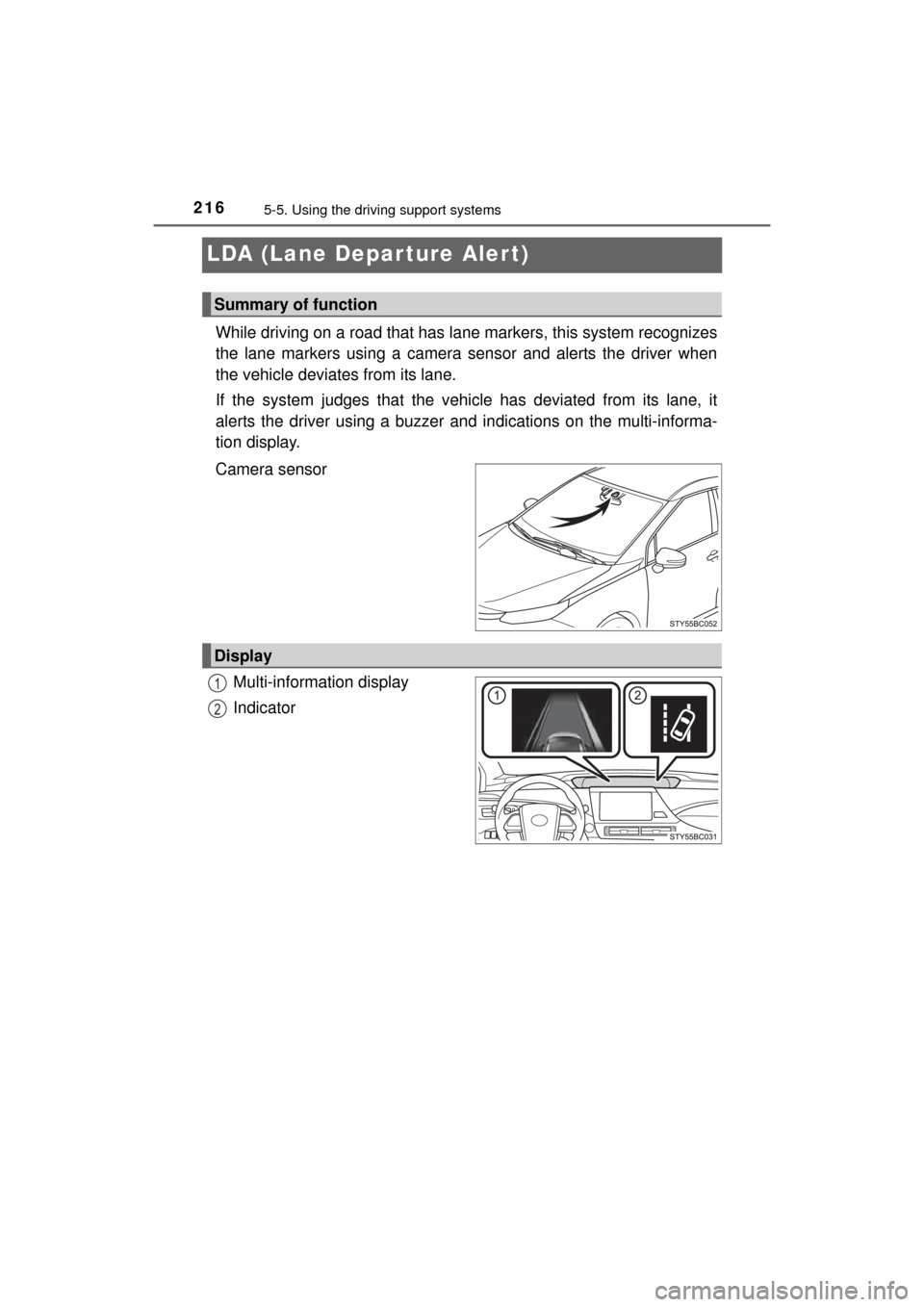
2165-5. Using the driving support systems
MIRAI_OM_USA_OM62004U
LDA (Lane Depar ture Alert)
While driving on a road that has la ne markers, this system recognizes
the lane markers using a camera sensor and alerts the driver when
the vehicle deviates from its lane.
If the system judges that the vehicle has deviated from its lane, it
alerts the driver using a buzzer and indications on the multi-informa-
tion display.
Camera sensor
Multi-information display
Indicator
Summary of function
Display
1
2
Page 218 of 464
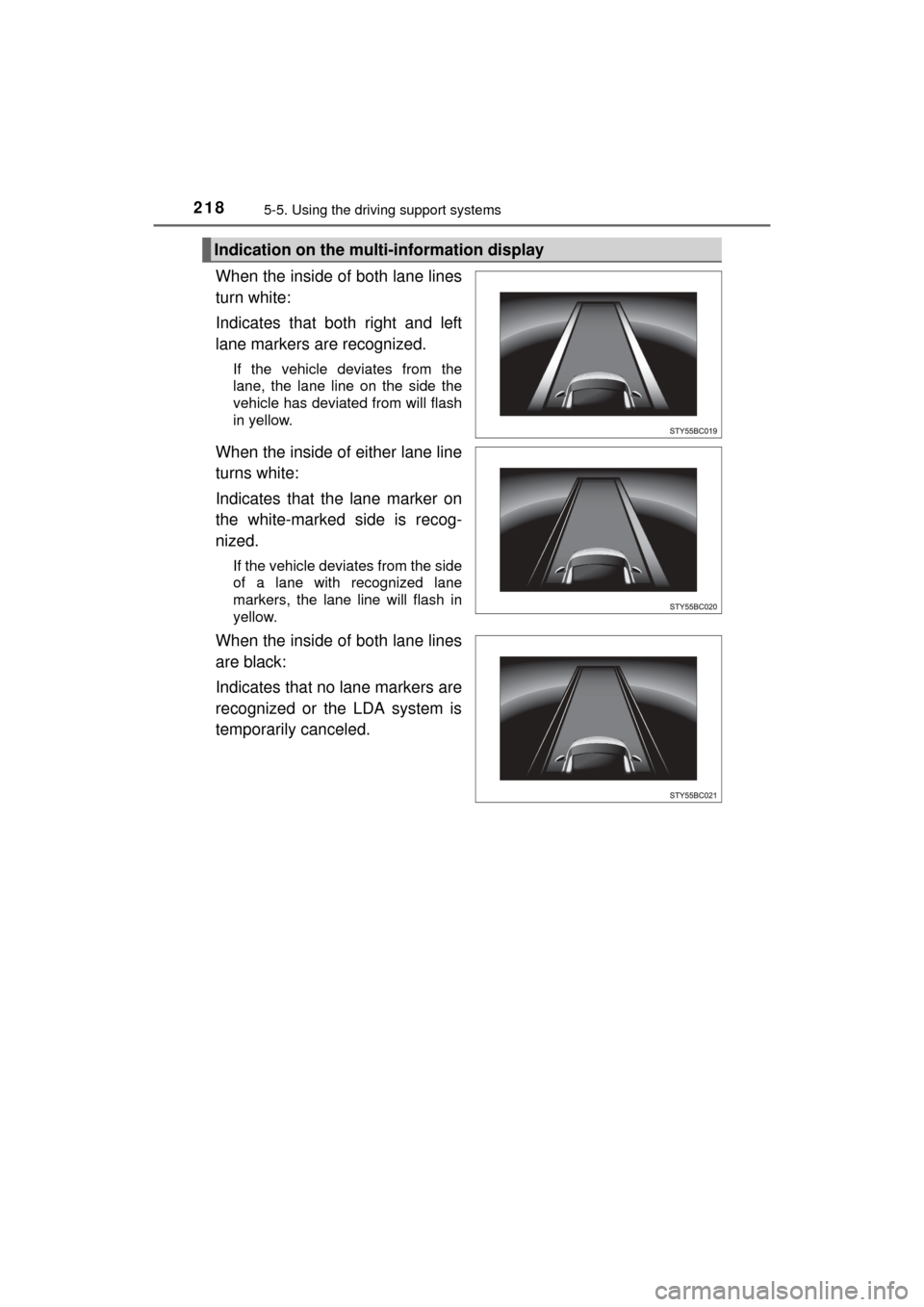
2185-5. Using the driving support systems
MIRAI_OM_USA_OM62004U
When the inside of both lane lines
turn white:
Indicates that both right and left
lane markers are recognized.
If the vehicle deviates from the
lane, the lane line on the side the
vehicle has deviated from will flash
in yellow.
When the inside of either lane line
turns white:
Indicates that the lane marker on
the white-marked side is recog-
nized.
If the vehicle deviates from the side
of a lane with recognized lane
markers, the lane line will flash in
yellow.
When the inside of both lane lines
are black:
Indicates that no lane markers are
recognized or the LDA system is
temporarily canceled.
Indication on the multi-information display
Page 219 of 464

2195-5. Using the driving support systems
5
Driving
MIRAI_OM_USA_OM62004U
■Temporary cancelation of the LDA system functions
If any of the following occurs, the LDA system functions will be temporarily
canceled. The functions will resume after the necessary operating conditions
have returned.
● The turn signal lever is operated.
● The vehicle speed deviates from the operating range of the LDA system
functions.
● When the lane lines cannot be recognized while driving.
● When the lane departure warning function is activated.
The lane departure warning function will not operate again for a several sec-
onds after it has been activated, even if the vehicle leaves the lane again.
■ Alert buzzer for lane departure alert
Depending on the audio system sound level or air conditioning fan noise
while the audio system or air conditioning system is in use, it may be difficult
to hear the alert buzzer.
■ After the vehicle has been parked in the sun
The LDA system may not be available and a warning message is displayed
for a while after driving has started. When the temperature in the cabin
decreases and the temperature around the camera sensor ( P. 216)
becomes suitable for its operation, turn the LDA switch on again after a
short time.
■ If there are lane markers on only one side of the vehicle
The lane departure alert will not operate for the side on which lane markers
could not be recognized.
Page 221 of 464
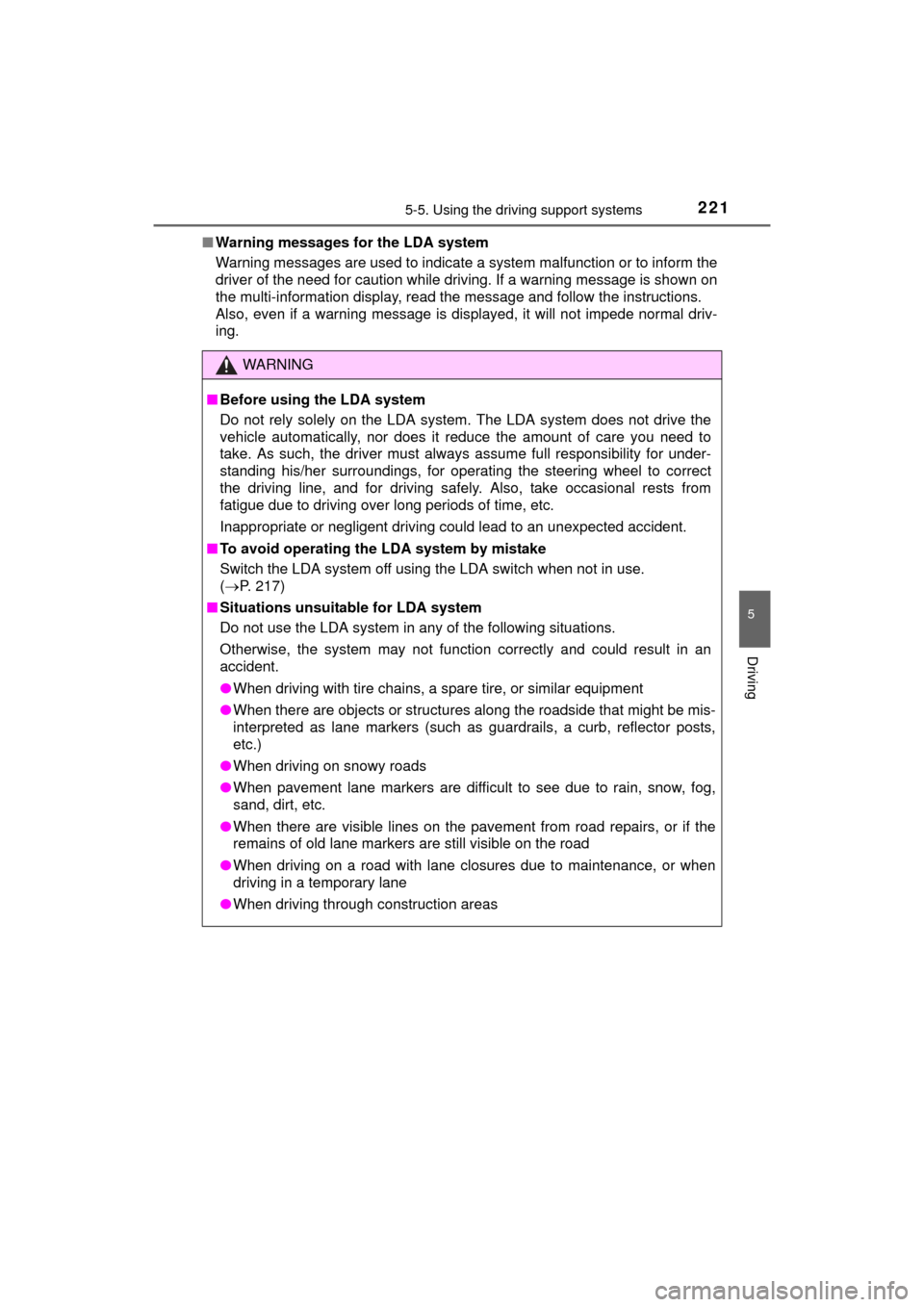
2215-5. Using the driving support systems
5
Driving
MIRAI_OM_USA_OM62004U■
Warning messages for the LDA system
Warning messages are used to indicate a system malfunction or to inform t\
he
driver of the need for caution while driving. If a warning message is sh\
own on
the multi-information display, read the message and follow the instructions.
Also, even if a warning message is displayed, it will not impede normal driv-
ing.
WARNING
■Before using the LDA system
Do not rely solely on the LDA system. The LDA system does not drive the
vehicle automatically, nor does it reduce the amount of care you need to
take. As such, the driver must always assume full responsibility for under-
standing his/her surroundings, for operating the steering wheel to correct
the driving line, and for driving safely. Also, take occasional rests from
fatigue due to driving over long periods of time, etc.
Inappropriate or negligent driving could lead to an unexpected accident.
■ To avoid operating the LDA system by mistake
Switch the LDA system off using the LDA switch when not in use.
(P. 217)
■ Situations unsuitable for LDA system
Do not use the LDA system in any of the following situations.
Otherwise, the system may not function correctly and could result in an
accident.
●When driving with tire chains, a spare tire, or similar equipment
● When there are objects or structures along the roadside that might be mis-
interpreted as lane markers (such as guardrails, a curb, reflector posts,
etc.)
● When driving on snowy roads
● When pavement lane markers are difficult to see due to rain, snow, fog,
sand, dirt, etc.
● When there are visible lines on the pavement from road repairs, or if the
remains of old lane markers are still visible on the road
● When driving on a road with lane closures due to maintenance, or when
driving in a temporary lane
● When driving through construction areas
Page 223 of 464

2235-5. Using the driving support systems
5
Driving
MIRAI_OM_USA_OM62004U
Intuitive parking assist
Front corner sensors
Rear corner sensors
Rear center sensors
The distance from your vehicle to nearby obstacles when paral-
lel parking or maneuvering into a garage is measured by the
sensors and communicated via the displays and a buzzer.
Always check the surrounding area when using this system.
Types of sensors
1
2
3
Page 224 of 464
![TOYOTA MIRAI 2016 1.G Workshop Manual 2245-5. Using the driving support systems
MIRAI_OM_USA_OM62004U
ON (activate)/OFF (deactivate) can be changed by the [set-
tings display] for the Mu lti-information Display (P. 107)
Press either TOYOTA MIRAI 2016 1.G Workshop Manual 2245-5. Using the driving support systems
MIRAI_OM_USA_OM62004U
ON (activate)/OFF (deactivate) can be changed by the [set-
tings display] for the Mu lti-information Display (P. 107)
Press either](/img/14/6549/w960_6549-223.png)
2245-5. Using the driving support systems
MIRAI_OM_USA_OM62004U
ON (activate)/OFF (deactivate) can be changed by the [set-
tings display] for the Mu lti-information Display (P. 107)
Press either or on the
meter control switches ( P. 108)
and select
Each press of of the meter control switches, changes ON and
OFF. When ON is selected, the in tuitive parking assist indicator
turns on.
Turning the intuitive parking assist system on
1
2
Page 225 of 464
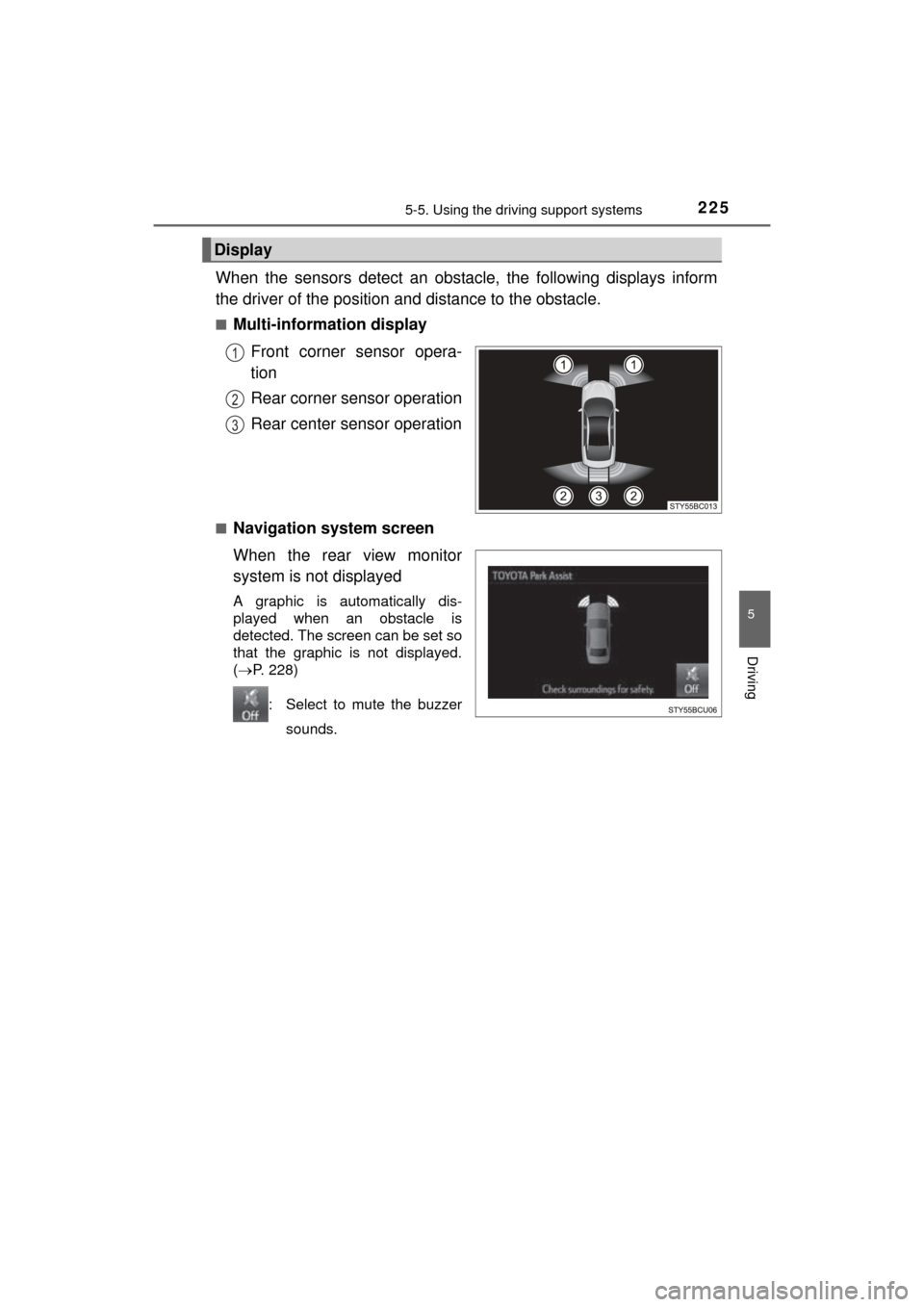
2255-5. Using the driving support systems
5
Driving
MIRAI_OM_USA_OM62004U
When the sensors detect an obstacle, the following displays inform
the driver of the position and distance to the obstacle.
■Multi-information display
Front corner sensor opera-
tion
Rear corner sensor operation
Rear center sensor operation
■Navigation system screen
When the rear view monitor
system is not displayed
A graphic is automatically dis-
played when an obstacle is
detected. The screen can be set so
that the graphic is not displayed.
( P. 228)
: Select to mute the buzzer sounds.
Display
1
2
3
Page 226 of 464

2265-5. Using the driving support systems
MIRAI_OM_USA_OM62004U■
Distance display
Sensors that detect an obstacle wi
ll illuminate continuously or blink.
*1: The images may differ from that shown in the illustrations. ( P. 225)
*2: Multi-information display
*3: Navigation system screen
Sensor detection display, obstacle distance
Display*1
Approximate distance to obstacle
Front corner sensorRear corner sensor/rear
center sensor
(continuous)
—
Rear center sensor only:
4.9 ft. (150 cm) to
2.0ft.(60cm)
(continuous)
2.0ft.(60cm) to
1.5ft.(45cm)2.0ft.(60cm) to
1.5ft.(45cm)
(continuous)
1.5ft.(45cm) to
1.0ft.(30cm)
Rear corner sensor:
1.5ft.(45cm) to
1.0ft.(30cm)
Rear center sensor:
1.5ft.(45cm) to
1.2ft.(35cm)
(blinking*2 or contin-
uous
*3)
Less than
1.0ft.(30cm)
Rear corner sensor:
Less than
1.0ft.(30cm)
Rear center sensor:
Less than
1.1ft.(35cm)
Page 228 of 464
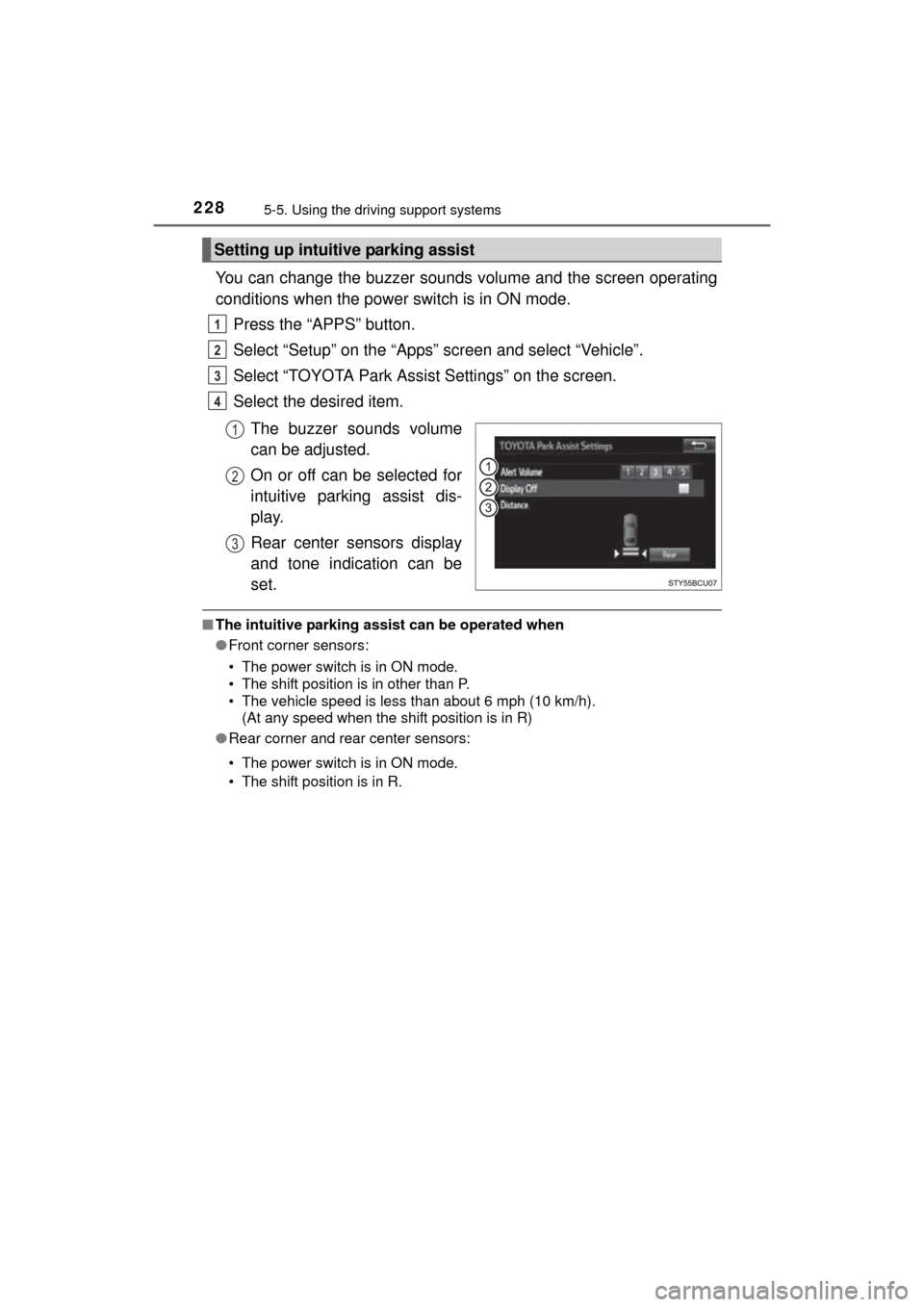
2285-5. Using the driving support systems
MIRAI_OM_USA_OM62004U
You can change the buzzer sounds volume and the screen operating
conditions when the power switch is in ON mode.
Press the “APPS” button.
Select “Setup” on the “Apps” screen and select “Vehicle”.
Select “TOYOTA Park Assist Settings” on the screen.
Select the desired item.
The buzzer sounds volume
can be adjusted.
On or off can be selected for
intuitive parking assist dis-
play.
Rear center sensors display
and tone indication can be
set.
■The intuitive parking assist can be operated when
●Front corner sensors:
• The power switch is in ON mode.
• The shift position is in other than P.
• The vehicle speed is less than about 6 mph (10 km/h).
(At any speed when the shift position is in R)
● Rear corner and rear center sensors:
• The power switch is in ON mode.
• The shift position is in R.
Setting up intuitive parking assist
1
2
3
4
1
2
3
Page 229 of 464
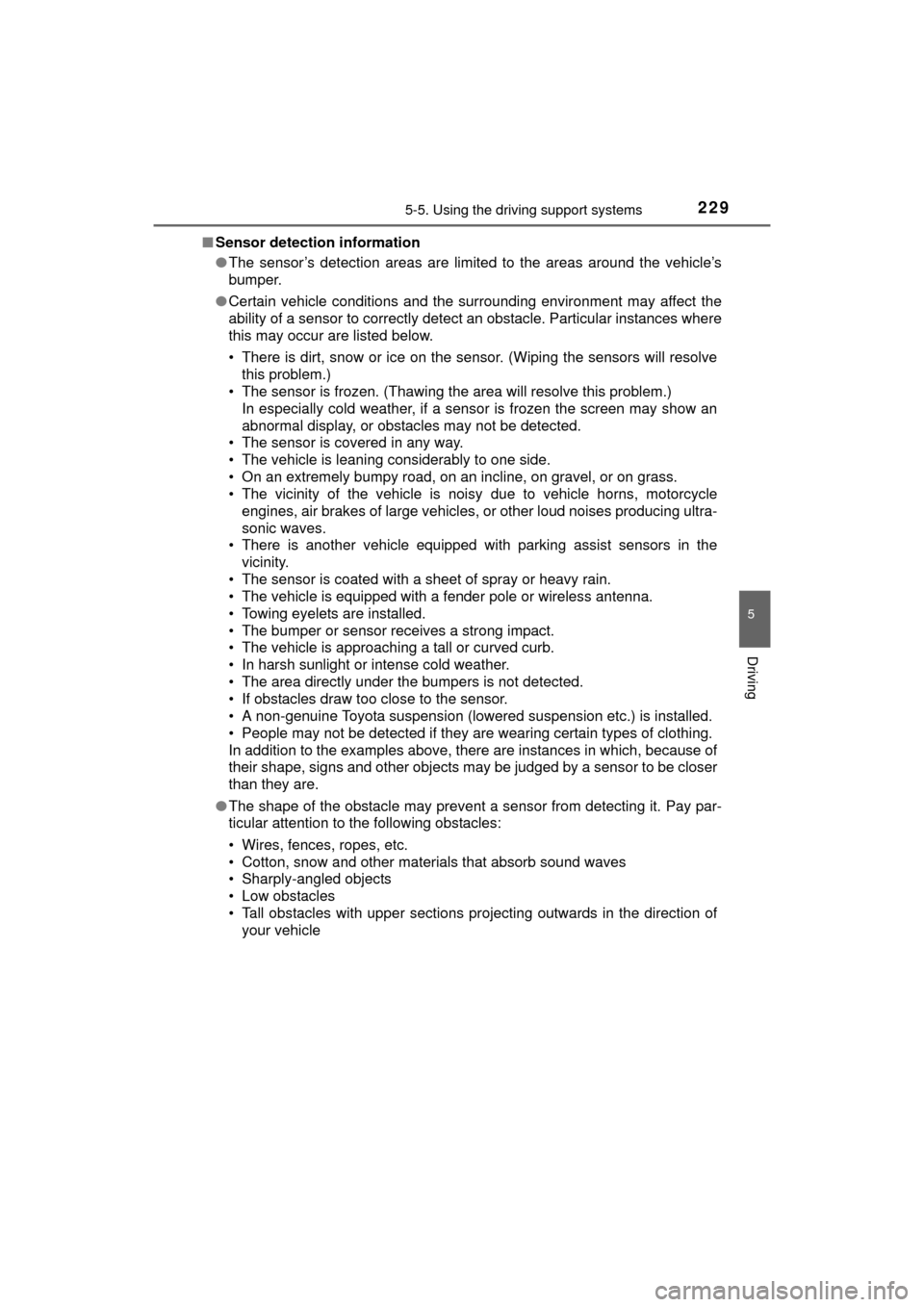
2295-5. Using the driving support systems
5
Driving
MIRAI_OM_USA_OM62004U■
Sensor detection information
●The sensor’s detection areas are limited to the areas around the vehicle’s
bumper.
● Certain vehicle conditions and the surrounding environment may affect the
ability of a sensor to correctly detect an obstacle. Particular instances where
this may occur are listed below.
• There is dirt, snow or ice on the sensor. (Wiping the sensors will resolve
this problem.)
• The sensor is frozen. (Thawing the area will resolve this problem.)
In especially cold weather, if a sensor is frozen the screen may show an
abnormal display, or obstacles may not be detected.
• The sensor is covered in any way.
• The vehicle is leaning considerably to one side.
• On an extremely bumpy road, on an incline, on gravel, or on grass.
• The vicinity of the vehicle is noisy due to vehicle horns, motorcycle
engines, air brakes of large vehicles, or other loud noises producing ultra-
sonic waves.
• There is another vehicle equipped with parking assist sensors in the
vicinity.
• The sensor is coated with a sheet of spray or heavy rain.
• The vehicle is equipped with a fender pole or wireless antenna.
• Towing eyelets are installed.
• The bumper or sensor receives a strong impact.
• The vehicle is approaching a tall or curved curb.
• In harsh sunlight or intense cold weather.
• The area directly under the bumpers is not detected.
• If obstacles draw too close to the sensor.
• A non-genuine Toyota suspension (lowered suspension etc.) is installed.
• People may not be detected if they are wearing certain types of clothing.
In addition to the examples above, there are instances in which, because of
their shape, signs and other objects may be judged by a sensor to be closer
than they are.
● The shape of the obstacle may prevent a sensor from detecting it. Pay par-
ticular attention to the following obstacles:
• Wires, fences, ropes, etc.
• Cotton, snow and other materials that absorb sound waves
• Sharply-angled objects
• Low obstacles
• Tall obstacles with upper sections projecting outwards in the direction of
your vehicle